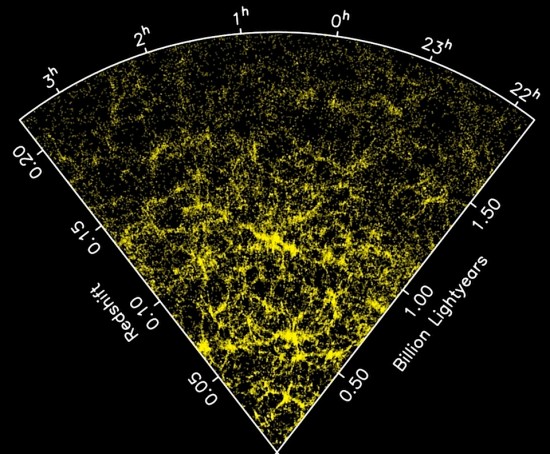
Galaxy distribution in the Universe according to their redshift. Credit: Sloan Digital Sky Survey two degree Field Galaxy Redshift Survey.
Apr 28, 2014
Can the Universe be weighed in the balance?
What causes the formation of compact galactic clumps and filaments? One proposal is that gravitational “tidal forces” pull stars and gas out of other galaxies as they pass by each other. Another suggestion is based on the movement of galaxies toward the center of galactic clusters. As they accelerate into the central mass of a cluster, “blow-back force” supposedly pushes galaxies out and away from the direction of travel like a cosmic comet tail.
However, neither conjecture is able to explain why the gas and star temperatures sometimes exceed tens of million Kelvin, generating powerful X-rays and vast radio signatures. Despite the theory that “ram pressure” creates friction as hot gases “scraping against each other” strip material from other galaxies in clusters, cosmologists still do not know why galaxies collect together in incredibly hot knots and tendrils.
According to a recent press release, scientists from the University of Pennsylvania claim to have measured the “weight” of galactic filaments, as well as the voids associated with them, by using so-called “gravitational lensing”. Gravitational lensing is the hypothetical way that gravity distorts the images of distant objects by “bending” light as it travels through space. Galaxies and galaxy clusters are thought to warp space because of their mass, so light does not travel in a straight line through regions of high density.
Stipulating a high percentage of dark matter in their computer simulations allowed them to conjure a method of weighing galactic filaments, but weighing the regions that are thought to be empty of matter gave them some difficulty. It was only when they assigned the voids a “negative mass” that their simulations worked. As University of Pennsylvania graduate student Joseph Clampitt said, “This means that voids act like objects with an effectively negative mass, such that even light rays bend away from them. They act roughly like concave lenses, the opposite of big galaxies, which act like convex lenses.”
In 1933, Fritz Zwicky found that his calculations for orbital acceleration and stellar mass within the Coma Cluster of galaxies was off by a factor of about 160. He surmised that something invisible to his instruments, otherwise known as dark matter, was holding it together. In 1979, Dennis Walsh, Bob Carswell, and Ray Weymann discovered two quasars with identical redshifts and spectra, leading them to speculate that it might be caused by another of Zwicky’s theories, a gravitational lens.
Astronomers believe that gravitational distortions are like ripples in water. As ripples pass over objects in the water, it causes their shapes to deform. As mentioned, it is that same effect on light passing through regions of varying dark matter density that causes ripples. Since dark matter is unseen and undetectable, and can be analyzed through inference alone, could it be that something else is taking place? Something that conventional observations fail to consider? In an Electric Universe, that “something” is electricity.
It is dark matter’s influence on galaxies and clusters that supposedly give the Universe its filamentary structure, say that University of Pennsylvania researchers. Their “breakthrough” in determining the amount of gravitational mass that causes that structure was to analyze millions of galaxy images from the Sloan Digital Sky Survey. That new analysis involved reprocessing those images in order to remove that atmospheric and instrument distortions that are larger that the signals they hoped to see. Since gravitational lensing is supposed to be symmetrical, removing any asymmetry “uncovered” the fact that voids in the Universe are not so empty: they are filled with dark matter.
In previous Picture of the Day articles, it was noted that structures in the Universe are active energy sources—some galaxies eject charged matter out from their poles, or leave long braided tails extending for thousands of light-years. Smaller formations (stars and planetary nebulae) have hourglass shapes composed of tightly bunched filaments. Such filamentary structures are known as Birkeland currents.
Almost every celestial body displays some kind of filamentation. Venus has a tail composed of what NASA scientists call “stringy things.” Comet tails are composed of “stringy” ion tails. The glow from planetary nebulae resolve into intricate webs. The jets of Herbig-Haro stars and energetic galaxies are often resolved into braided filaments, and the spiral arms of some galaxies look “hairy” with threads of material extending from them.
All those filaments are Birkeland currents, but they only represent the visible portion of an entire circuit. The rest of the circuit may generate magnetic fields that can be mapped, so the map will indicate the extent of the circuit. Every element in a galactic circuit radiates energy, and it must be powered by its coupling with larger circuits. The extent of those larger circuits is indicated by the observation that galaxies occur in strings.
It seems apparent that filaments, knots, and voids are examples of electricity in space forming glowing “fireballs” of plasma, as well as electromagnetically pinched zones of cosmic Birkeland currents. If astronomers were to analyze the Universe in terms of electric charges and the currents through space, rather than the fictional ideas of dark matter gravity and space warping like ripples in water, the shape of the cosmos would look much different.
“Of course, if one ignores contradictory observations, one can claim to have an ‘elegant’ or ‘robust’ theory. But it isn’t science … The crucial quality of science is to encourage, not discourage, the testing of assumptions.”
— Halton Arp, Science News, July 27, 1991.
Stephen Smith
Click here for a Spanish translation












